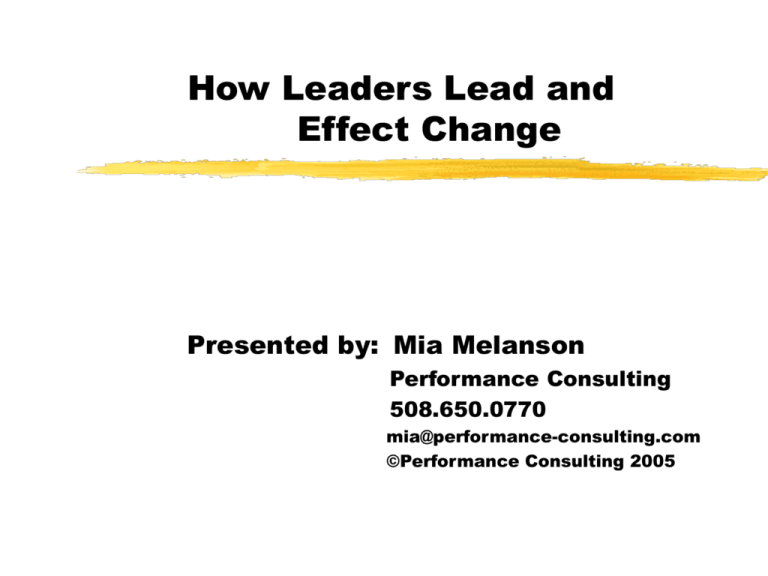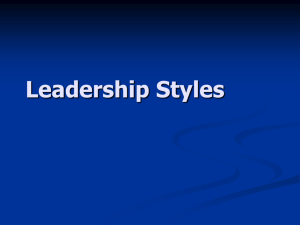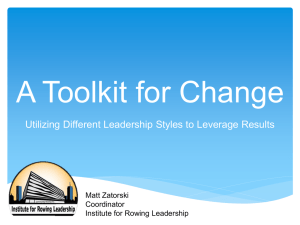How Leaders Lead and Effect Change
advertisement

How Leaders Lead and Effect Change Presented by: Mia Melanson Performance Consulting 508.650.0770 mia@performance-consulting.com ©Performance Consulting 2005 Leaders, Managers, and Change Agenda & Fundamental Questions How are leaders and managers different? How do leaders lead? What is the new vision, and strategy to achieve the vision/change? How is it articulated? Case study #1 Case study #2 How is change received and accommodated? Essential steps for effective change Management versus Leadership Exercise: 1. Define leadership 2. In groups of 5-7, identify your activities in your role as help desk manager or supervisor. Which are leadership activities, which are management activities? Leadership Effective leaders: Challenge the process; they are innovators Inspire a shared vision; they focus on goals Enable others to act; they are team builders Model the way; they walk the talk Encourage the heart with visible signs of support; they are advocates for their teams Leadership versus Management Leaders: Managers: Innovate Ask what and why Do the right thing Are not afraid to engage conflict and work through it to accomplish change Initiate transformations, endings, transitions, new beginnings Implement Ask how and when Do things right View conflict as counterproductive and prefer cooperation to accomplish procedures Maintain order, consistency, harmony Leadership Styles Coercive Authoritative Affiliative Democratic Pacesetting Coaching Coercive Leadership Style Attributes Modus operandi Competencies Situation to be effective Overall impact Demands immediate compliance Drive to achieve, selfcontrol, initiative Crisis, turnaround, w/ problem employees Negative Authoritative Leadership Style Attributes Modus operandi Competencies Situation to be effective Overall impact Mobilizes people toward a vision Empathy, change catalyst, confidence When clear direction is needed, new vision needed Most strongly positive Affiliative Leadership Style Attributes Modus operandi Competencies Situation to be effective Overall impact Creates harmony, emotional bonds Communication, empathy, relationships Healing rifts in a team, motivating in stressful circumstances Positive Democratic Leadership Style Attributes Modus operandi Competencies Situation to be effective Overall impact Forges consensus through participation Collaboration, team leadership, communication Getting input input from valued employees, building buy-in Positive Pacesetting Leadership Style Attributes Modus operandi Competencies Situation to be effective Overall impact Sets high standards for performance Drive to achieve, initiative, conscientiousness Getting results from a highly motivated and competent team Negative Coaching Style of Leadership Style Attributes Modus operandi Competencies Situation to be effective Overall impact Develops people for the future Empathy, selfawareness, developing others Helping an employee improve performance, developing long-term relationships Positive Change Strategy Articulation Essential Processes Critical Metrics Strategic Objectives Vision, Mission, Values Articulating Change Exercise: 1. Describe an organizational change that you’ve experienced. 2. In your groups, share your experiences. Then choose one scenario and write the key details that were or should have been articulated: vision, mission, values; strategic objectives; critical processes; metrics; new roles and responsibilities Sample Strategy Map Drivers Vision “We will be the global industry leader in sales and service by valuing our customers and employees and shareholders.” Market Differentiators Strategic Objectives Vital Measures Critical Processes • • • • • Achieve an unparalleled level of customer satisfaction Develop a diverse and high-quality workforce Customer Satisfaction Index Employee Satisfaction Manage the installation process Respond to customer Communicate with customer Provide products Set, manage, & document customer expectations and desires Mission Values “We are a global, customer-focused sales and service team. We handle more customers than any other - in the world and strive to deliver: consistent, quality customer care , proactive and innovative services, enhanced service recovery, and increased revenue, through technology and informed, empowered employees.” • Value Employees, Customers and Shareholders • Honesty, Integrity and Respect • Inclusive, High-Performing Team Culture • Safety • Creating a Great Place to Work Call Handling Capabilities Our People • • • • Attract and hire Train and develop Evaluate, recognize, & reward Integrated communications (©North Highland Co.) Online Support Develop and deliver innovative technology solutions % Revenue Growth • Monitor and evaluate key products and services performance • Market and sell Customer Service Orientation Increase revenue and profitability Serve as consultant on how to best support products and partners Service Recovery Maintain and promote a safe work environment On-time General Product Release Time-to-Market for New Business Units % Revenue from New Business Units • Product development & business plan process • Product life cycle management • Build thru installation process • Revision, warranty, maintenance, & service • Develop services business plan • Acquire knowledge resources to develop services • Continuous education and training • Develop business plan • Identify and develop partnerships/alliances • Educate employees on doing business internationally • Develop local comp. presence • Multi-lingual workforce Change Program for Improved Customer Care Company Background Audio systems firm established in the 1960’s Complex, technical products Research-driven company Intention to provide “one call does it all” support Two support groups merged Preferred employer in region Change Program for Improved Customer Care Objectives Improve service levels through reducing transfers Make available more knowledgeable staff at first contact More efficiently utilize support personnel Provide career path within customer support Utilize supervisor/peer coach model Change Program for Improved Customer Care Implementation 18 month roll-out beginning with formal presentation of strategy with follow-up meetings Objectives & benefits clearly stated & publicized Definition of roles & responsibilities, job descriptions, specific examples Hiring profile defined, 13 new hires Transition program implemented: train, train…. Change Program for Improved Customer Care Metrics Customer feedback/satisfaction survey Team acknowledgement of success Improved morale, professionalism, knowledge Success Factors Multi-level product & technical support specialist positions with identified objectives Recognition program encouraging performance Ongoing training & coaching Hindsight is 20/20 Additional Initiatives More effective coaching to assist with individual transition More aggressive employee termination / relocation plan Longer roll-out plan Key understanding that management and employees view change differently All in all, change initiative was successful Situational Leadership: Enabling Others to Act Directing Coaching Supporting Delegating Situational Leadership: Enabling Others to Act Directing Coaching Low competence High motivation New hire Higher competence Lower motivation Relatively new employee - new task Leader: sets goals identifies roles provides specific direction Leader: sets goals, plans consults with team member for ideas Situational Leadership: Enabling Others to Act Supporting Delegating High competence Needs encouragement Experienced analyst High competence High motivation Team lead Leader: Leader: Collaborates with team member to set goals Team member defines how Shared decision-making Collaborates with team member to set goals Team member is empowered to act, requests resources. input Steps for Effectively Implementing Change Analyze your current business situation, identify the need for change and why Create a sense of urgency Assemble a leadership team Establish a new vision and mission Develop strategies to achieve the vision Clearly communicate the vision, objectives and strategies to achieve them, use maps - visuals Steps for Effectively Implementing Change Redefine roles and responsibilities Garner or provide necessary resources Train, train, train - enabling many to implement Allow just enough time for success Publicize and celebrate short-term wins Evaluate at appropriate intervals Redesign as necessary Adopting to Change Innovators Early Majority Early Adopters Late Majority Laggards Accommodating Change shock denial & isolation Accommodation envision growth new opportunities bargaining building anger guilt & remorse panic depression acceptance of reality resignation to situation Change versus Transition Change is an event that is situational and external to us Transition is the experience of the gradual, psychological reorientation process that happens inside of us Endings - disengage from “what was” Neutral Zone - confusion, in-between state New Beginnings - familiar with “what will be”, acceptance of new reality Helping with Transition Remember: Each team member handles transition differently Be visible in offering assistance Communicate early and often, group, one-on-one, publications Ask for feedback Focus on success Reward success How Leaders Lead and Effect Change Presented by: Mia Melanson Performance Consulting 508.650.0770 mia@performance-consulting.com ©Performance Consulting 2005








